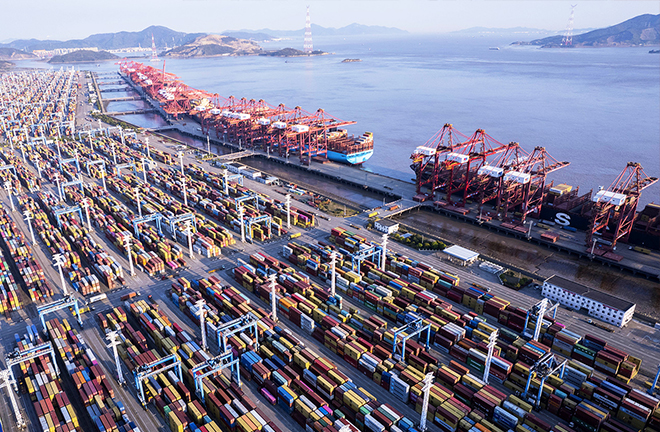Modernizing industrial system amid new development pattern

The Port of Ningbo Zhoushan in the eastern province of Zhejiang Photo: CFP
Building an independent and controllable modern industrial system is a vital strategic deployment proposed by the CPC Central Committee in response to changing domestic and international development environments in recent years. Its implementation must be understood amid the new development pattern, which is of vital significance to promoting the country’s high-quality economic development.
Multiple challenges
From an external perspective, profound changes unseen in a century are evolving at an accelerated pace, and the global political and economic landscape is undergoing profound changes. Meanwhile, the global industrial division of labor system is facing deep adjustments, and a series of new development trends such as inward contraction, local transfer and regional clustering are emerging. Countries are increasingly competing for the dominance of supply chains, shifting from prioritizing efficiency to increasingly emphasizing security, controllability, and resilience.
Domestically, 2022 saw negative population growth in China for the first time; the construction of a modern industrial system is facing the reversal of the “demographic dividend.” The growth potential of traditional inputs is diminishing with measures such as intensive land use and the pursuit of the “dual carbon” goals. The enhancement of the total factor productivity (TFP) is urgently needed as the fundamental source of industrial development.
Coordinating supply and demand
Amid the new epochal context, the traditional development model that relies on international circulation is no longer sustainable. It must be transitioned to an industrial development model that focuses on domestic economic circulation. On the demand side, large-scale and structurally upgraded domestic demand should be used to drive and generate high-quality supply. On the supply side, independent, controllable, high-quality and efficient technology, and factor of production supply should be harnessed to continuously meet, upgrade, and create demand. This will contribute to building an independent, controllable, safe, and reliable modernized industrial system.
From a demand-driven perspective, China has formed a large-scale manufacturing industry and a complete industrial system, with a population of over 1.4 billion and a middle-income group of over 400 million. This huge domestic demand market is an important condition for inducing technological innovation, reducing technological innovation costs, and gathering innovative talent and resources. In order to modernize the industrial system amid the new development pattern, it is necessary to fully attach importance to and rely on the domestic market, shifting from “promoting domestic growth with international flow” to “promoting international flow with domestic flow,” and ensuring the orderly connection and efficient matching of various links along industrial chains, thus becoming a strong internal driving force for the construction of a modern industrial system.
From a supply-driven perspective, technological self-reliance and self-improvement are important guarantees for improving the quality and level of the supply system and enhancing the modernization level of the industrial chain. To this end, we should not only focus on long-term interests, promote strategic technology and core technology research and development (R&D) from the source, while benchmarking against the frontiers of the world, but also focus on the current situation, promote the collaborative R&D of industrial and innovation chains around key industrial chains and links, focus on strengthening chain replenishment and extension, and cultivate a group of chain masters to achieve quality improvement and structural upgrading on the supply side.
Going forward
Firstly, the advantages of a new system for mobilizing resources nationwide should be leveraged. Through deployment and pooling of high-quality resources in advance, we can collaborate to tackle key problems and promote technological innovation.
Secondly, it is important to proactively design the future industrial chain architecture of the Chinese manufacturing sector. This involves prioritizing key industries and areas, strengthening the supporting capabilities of industrial chain services, and implementing projects that extend and supplement these chains.
Thirdly, efforts should be made to support the growth of world-class leading enterprises. The cultivation of enterprises with the characteristics of “specialization, refinement, uniqueness and innovation” should be accelerated. In order to enhance dominance, discourse, and control along global value chains (GVCs), a collaborative system of “chain masters + specialized champions” can be established during the development process.
Fourthly, the scale advantage of China’s domestic market should be leveraged to provide large-scale application scenarios and continuous iteration opportunities for technological breakthroughs. This will attract high-level global resource factors and drive high-level supply with high-quality demand, striking a dynamic balance between high-standard supply and demand.
Liu Weilin is a professor from the College of Economic and Social development at Nankai University.
Edited by ZHAO YUAN
